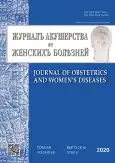Urethrovesical segment ultrasound for the efficacy evaluation of surgical treatment of stress urinary incontinence
- Authors: Kira K.E.1, Bezhenar V.F.2, Prokhorova V.S.3
-
Affiliations:
- Leningrad Regional Clinical Hospital
- Academician I.P. Pavlov First Saint Petersburg State Medical University
- The Research Institute of Obstetrics, Gynecology, and Reproductology named after D.O. Ott
- Issue: Vol 69, No 6 (2020)
- Pages: 43-48
- Section: Original study articles
- URL: https://bakhtiniada.ru/jowd/article/view/59239
- DOI: https://doi.org/10.17816/JOWD69643-48
- ID: 59239
Cite item
Abstract
Hypothesis/Aims of study. At present, there is no doubt about the importance of the problem of female stress urinary incontinence (SUI) and the search for the best way to eliminate it. Sling operations in SUI treatment are the most popular in world and domestic practice. However, they are not without certain complications. In this regard, it becomes relevant to determine the factors for predicting their effectiveness and safety. The aim of this study was to conduct a comparative study of the effectiveness of two anti-stress operations: TVT-Obturator® and urethrovesicopexy with vaginal flap, by using echography of the urethrovesical segment.
Study design, materials and methods. During the period from 2011 to 2018, 105 incontinent patients were examined and operated on. Two groups were formed: Group 1 consisted of 52 patients who underwent TVT-Obturator® surgery, Group 2 included 52 patients who underwent urethrovesicopexy with vaginal flap. In all patients, the anatomical topographic position of the bladder and urethrovesical segment, the internal urethral sphincter status, as well as the angles α and β were determined, based on which the conclusion about the type of SUI was made and, accordingly, the adequate method of surgical intervention was determined.
Results. Before the operation, the angle α averaged 37.2 ± 10.11, with 24.7 ± 4.64 a year after the operation and 26.8 ± 3.72 five years after the operation. Rotation of the angle α in the study groups >20° before surgery did not significantly affect the presence of long-term complications, urinary retention after a year and five years, and recurrence of urinary incontinence. After the operation, there was an increase in the angle β after a year (p = 0.0032) and five years (p = 0.0035) and in the total urethral length after a year (p = 0.0022), but after five years, this parameter did not differ significantly from that before surgery (p = 0.29).
Conclusion. TVT-Obturator® and urethrovesicopexy with vaginal flap are equally effective (p > 0.05) in the surgical treatment of female SUI in both the nearest postoperative period (96.2% and 94.3%, respectively) and the distant period (90.4% and 88.7%, respectively).
Full Text
##article.viewOnOriginalSite##About the authors
Ksenia E. Kira
Leningrad Regional Clinical Hospital
Author for correspondence.
Email: ksenia_kira@mail.ru
MD
Russian Federation, Saint PetersburgVitaly F. Bezhenar
Academician I.P. Pavlov First Saint Petersburg State Medical University
Email: bez-vitaly@yandex.ru
ORCID iD: 0000-0002-7807-4929
SPIN-code: 8626-7555
MD, PhD, DSci (Medicine), Professor, Head of the Department of Obstetrics, Gynecology, and Neonatology
Russian Federation, Saint PetersburgVictoria S. Prokhorova
The Research Institute of Obstetrics, Gynecology, and Reproductology named after D.O. Ott
Email: viprokhorova@yandex.ru
ORCID iD: 0000-0002-4421-7901
SPIN-code: 2450-7154
MD, PhD, Head of the Ultrasound Department
Russian Federation, Saint PetersburgReferences
- Лоран О.Б. Эпидемиология, этиология, патогенез, диагностика недержания мочи // Урология. – 2001. – № 2. – С. 11−21. [Loran OB. Ehpidemiologiya, ehtiologiya, patogenez, diagnostika nederzhaniya mochi. Urologiia. 2001;(2):11-21. (In Russ.)]
- Abrams P, Cardozo L, Khoury S, Wein A, ed. Incontinence. 4th ed. 2009. In: 4th International Consultation on Incontinence, Paris July 5-8, 2008. Health Publication Ltd.; 2009. Available from: http://www.icud.info/PDFs/Incontinence.pdf.
- Краснопольский В.И., Попов А.А., Горский С.Л., и др. Возможности и перспективы малоинвазивных методов коррекции стрессового недержания мочи // Журнал акушерства и женских болезней. – 2000. – T. 49. − № 4. – С. 23−25. [Krasnopol’skii VI, Popov AA, Gorskii SL, et al. Vozmozhnosti i perspektivy maloinvazivnykh metodov korrektsii stressovogo nederzhaniya mochi. Journal of obstetrics and women’s diseases. 2000;49(4):23-25. (In Russ.)]
- Безменко А.А. Лечение стрессового недержания мочи у женщин методом подлонной уретровезикопексии влагалищным лоскутом: автореф. дис. ... канд. мед. наук. – СПб., 2002. – 24 с. [Bezmenko AA. Lechenie stressovogo nederzhaniya mochi u zhenshchin metodom podlonnoi uretrovezikopeksii vlagalishchnym loskutom. [dissertation] Saint Petersburg; 2002. 24 р. (In Russ.)]
- Чечнева М.А. Клиническое значение ультразвукового исследования в диагностике стрессового недержания мочи: автореф. дис. … канд. мед. наук. – М., 2000. – 20 с. [Chechneva MA. Klinicheskoe znachenie ul’trazvukovogo issledovaniya v diagnostike stressovogo nederzhaniya mochi. [dissertation] Moscow; 2000. 20 р. (In Russ.)]
- Chen GD, Su TH, Lin LY. Applicability of perineal sonography in anatomical evaluation of bladder neck in women with and without genuine stress incontinence. J Clin Ultrasound. 1997;25(4):189-194. https://doi.org/10.1002/(sici)1097-0096(199705)25:4<189::aid-jcu6 > 3.0.co;2-a.
- Chene G, Cotte B, Tardieu AS, et al. Clinical and ultrasonographic correlations following three surgical anti-incontinence procedures (TOT, TVT and TVT-O). Int Urogynecol J Pelvic Floor Dysfunct. 2008;19(8):1125-1131. https://doi.org/10.1007/s00192-008-0593-z.
- Ghoniem GM, Rizk DE. Renaissance of the autologous pubovaginal sling. Int Urogynecol J. 2018;29(2):177-178. https://doi.org/10.1007/s00192-017-3521-2.
Supplementary files











